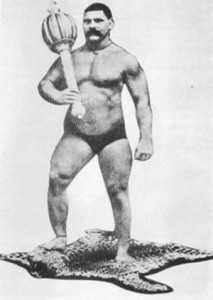A number of new scholarly books on martial arts have come across my desk in the last month. This field is in its infancy and I am exited to be part of the project of defining and inspiring it. In that spirit, there is much in these works
to praise, much
to criticize, a yawn here and there, and a few things that need to be
stopped dead in their tracks.So this is the second of a series in which I will discuss individual essays within larger works. The following essays are from a collection edited by Thomas A. Green and Joseph R. Svinth titled,
Martial Arts in the Modern World (Praeger, 2003).
__________
Svinth and Green's
"The Circle and the Octagon: Maeda's Judo and Gracie's Jiu-Jitsu," traces the interaction between Judo players and Wrestling in the early 20th Century. Maeda Misuyo made the leap from Judo to competitive wrestling, starting in America, and then in England, Spain, Mexico, Cuba, and finally Brazil. But competitive wrestling has the problem that it is either over in a few seconds, or it lasts for hours with little action. So most of the wrestling involved slap stick and elaborate back stories and costumes. He was a huge star, especially in Mexico and Cuba. In Brazil he was part of a circus show, where he met the Gracie brothers who were also in the circus. He taught them Judo and the rest is history. In summary,
neener, neener, neener, MMA (Mixed Martial Arts) comes from the circus and is a kissing cousin of
WWE.
__________
Graham Noble's "The Lion of the Punjab: Gama in England, 1910," tells the story of an extraordinary South Asian Wrestler named Gama who traveled with two other top wrestlers to the heart of the British Empire to claim the title of the world's greatest wrestler. Do to the fact that most of the pro-wrestlers were performance artists with superb slap-stick skills, he had a terrible time getting anyone to allow themselves to be smacked down
for real. As an American reading the story I was cheering for him to humiliate a few of the old Colonials. But the expression 'chicken' is too good for them. Finally a sympathetic American was recruited from New York to fight him and was soundly defeated. They found a guy from Poland to fight him too. Gama and his crew, after 6 months of waiting, returned home having had only a handful of fights. The account of his rise in India, his insane workouts, and his drive to succeed, are inspirational. A timeless tale of human achievement, stuck in a strange moment in time.

__________
Thomas A. Green has two essays on African martial arts,
"Surviving the Middle Passage: Traditional African Martial Arts in the Americas," and, "
Freeing the Afrikan Mind: The Role of Martial Arts in Contemporary African American Cultural Nationalism." Green must get credit for publishing first on these extremely interesting topics. Unfortunately I already devoured TJ DESCH-OBI's,
Fighting for Honor (2008), which
I loved and reviewed here. Obi's notion of honor makes these essays somewhat out of date and goes a long way toward explaining the unique forms of African Nationalist martial arts Green describes in
Freeing the Afrikan Mind.
___________
James Halpin's
"The Little Dragon: Bruce Lee (1940-1973)," is the best succinct history of Bruce Lee I've ever read. His father was a comic opera star, which is really where he got his chops. He was a rich kid that wanted street cred, so he trained at the Wing-tsun school and got involved in illegal competitive roof top fights. He got busted and in court his mom asked the judge if she could send him out of the country instead of to jail, and that's how he ended up in the United States. His ex-girlfriend said he had the maturity of a 12 year old. He gave amazing lecture demos, published a book on the philosophy of martial arts, and wrote the original screenplay for the Kung Fu television series. Lee was an awesome egomaniac who transfixed a generation and propelled the martial performing arts of China into an international sensation. He died from an allergic reaction to a large Aspirin. The essay covers a lot of territory, and draws on many sources.
___________
to be continued....

 __________
__________ __________
__________